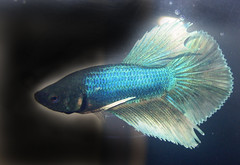Moving or traveling with Betta fish
 I don’t talk about my fish on here nearly as much as I thought I would. Since I was 16, I’ve kept at least one (and as many as nine) Betta fish as pets. Over that period, I’ve kept a total of more than two dozen different Bettas, both male and female. I’ve also had to move and travel over distances ranging from 100 to 850 miles while transporting as many as three fish at a time. I’ve been meaning to write up my method for transporting a fish over long distances by car for quite some time, and I sort of inadvertently wrote it while providing advice to someone on r/Aquariums last night. I’m mostly just taking the text from my response there and incorporating it into this post.
I don’t talk about my fish on here nearly as much as I thought I would. Since I was 16, I’ve kept at least one (and as many as nine) Betta fish as pets. Over that period, I’ve kept a total of more than two dozen different Bettas, both male and female. I’ve also had to move and travel over distances ranging from 100 to 850 miles while transporting as many as three fish at a time. I’ve been meaning to write up my method for transporting a fish over long distances by car for quite some time, and I sort of inadvertently wrote it while providing advice to someone on r/Aquariums last night. I’m mostly just taking the text from my response there and incorporating it into this post.
As a general rule, fish and car rides don’t mix…at least not on a regular basis. That said, it is possible to travel by car with your fish from time to time, provided you do a few things to reduce any motion the fish has to deal with, prevent splashing or leaking, and make sure that the trip is the only stress your fish has to deal with. Also, I have had a few bettas that actually seem to enjoy (or at least not mind) the dynamic nature of a car trip, but they’re definitely the exception.
What you’ll need
- A box with high sides that will fit securely behind the driver’s seat of your car or can be secured near your vehicle’s center of gravity.
- Container(s) with a lid or splashproof cover that will fit in the box and are sufficiently large to temporarily house your fish.
- Blankets or towels for securing the containers inside the box.
- Enough water from your place of departure to cover water changes or transitions to the water at your destination.
- Your fish’s usual food, water treatment chemicals, and water change equipment.
- Optional: A silk plant and/or some substrate (gravel or marbles)
- Optional: A digital thermometer with remote sensor
The process
First of all, I’d recommend only transporting your fish when you’re going to be gone longer than two weeks and/or you absolutely can’t find anyone to feed your fish while you’re away. Any longer than two weeks and you’ll have to find someone you trust to perform tank/water maintenance. (You should typically perform said maintenance more regularly than every two weeks, but the decline in water quality over that period is usually less stressful than a car trip.)
If you ARE transporting your fish, you have to make sure you can secure it properly. I’ve transported a lot of fish over long distances (moving and extended stay trips), and I’ve found that the best place to put the fish is either secured on the floor behind the driver’s seat in a car, or secured just behind the space between the front seats in a van (or some SUVs). The trick is to secure the tank or container with the fish in it as close to the center of gravity of the vehicle as possible. This is where there will be the fewest inertial forces exerted on the fish and the water in the tank as you accelerate, decelerate and turn.
I recommend transporting the fish in a half-full container of clean, treated water with no substrate, decorations, or items of any sort and a lid or cover that will contain the majority of splashes. (I’ve had the best luck with smaller tanks–2.5 gallons or less.) This is to prevent injury to the fish if you go over any bumps or have to make sudden adjustments and, of course, to prevent water from getting all over your car. Place that container inside of a box and pad/secure it with towels or blankets. Then secure the box in the place that is the closest you can get to the center of gravity of the vehicle. Secure means that it it cannot slide or tip over, no matter what forces are exerted on it. I usually wedge it between the back of the driver’s seat and the back seat on the floor.
Before you leave, put into containers (empty and rinsed soda bottles or milk jugs work well) enough water from where you’re departing from to take your fish through any necessary water maintenance while you’re away. This will help keep your water parameters the same and reduce any additional stress on your fish. If the amount of water you would have to take is impractical, bring enough to slowly transition your fish to the water at your destination, then bottle enough of that water to make the transition back upon your return. This is one of the first things I learned about moving with fish–the combined stress of the move and the immediate change to different water caused the first Betta I moved with to develop a number of stress-related health problems I could never get ahead of. Ever since, I’ve packed a supply of water, and I’ve never had that problem again.
If you’re traveling in cold or hot weather, you will have to plan your stops and adjust your use of the heat or AC so as not to let the water temperature be affected by fluctuations in the temperature in your car. A digital thermometer with a remote sensor next to the tank is helpful in making sure your fish isn’t too cold or hot during the trip.
When you arrive at your destination, use the water you brought (after you’ve treated it, of course) to refill the tank. If you brought along a silk plant, go ahead and put that in the tank. Wait until you’re due for a full water maintenance before adding back any substrate. If you’re making a return trip, make sure to take it out again before traveling.



Hey buddy,
Thank you very much for this write up.